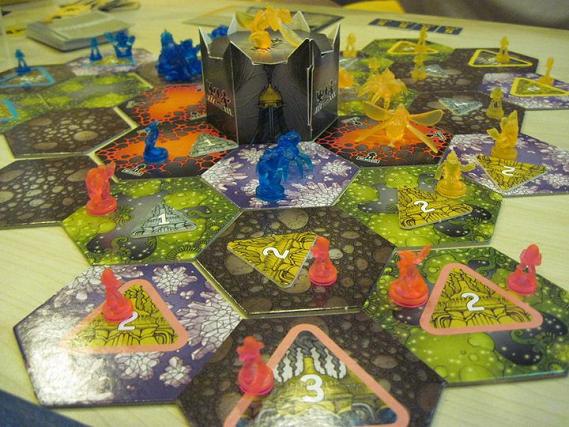22 Oct

The very garishly colored hex tiles that make up the board, with the cardboard monolith in the center.
Nexus Ops is an Ameritrash, lightweight wargame that we played recently at CarcaSean. Frankly, after playing it I’m pretty mystified at how well it seems to be regarded on BGG. I’m also curious that its current price seems quite high given that it’s out of print. In case anyone is interested, I noticed a brand new copy of this game sitting on a shelf at Comics Mart Midvalley in Kuala Lumpur about a month ago.
It’s old, out of print and there are plenty of reviews on BGG, so I’ll just jot down some thoughts:
- The board is made up of hex tiles so there’s some variation from game to game. Face down counters are placed on them at the beginning of the game, so you get an exploration bonus when you’re the first to get a unit there. This is either a mine on that hex or some free units.
- It’s a victory-point based game and you get points almost exclusively by winning battles, so this is game of aggression. Basically you get one point for winning a battle by collecting the regular Mission cards or you can play a Special Mission from your hand if you fulfill its conditions to earn its points. While the Special Mission cards are kind of neat, I think that awarding points one at a time using the Mission cards feels very cumbersome.
- At the beginning of every turn, you spend your resources to buy units and place them in your starting area. Then you get to move all your units on the board. You earn resources for mines which you control. Battles are quick to resolve. Basically the better and more expensive the unit, the earlier and the easier it hits. The defender chooses which units to lose. Units which die before it’s their turn to fight don’t get to hit at all.
- The winner gets to play Mission cards for points as mentioned while the loser gets to draw an Energize card as compensation. This gives some nifty bonuses in future battles. Actually, we forgot to follow this rule consistently in our game and I never drew even one of these cards though I lost plenty of battles. The player who controls the central monolith gets to draw two of these Energize cards every turn.
- Each unit except the cheapest and weakest humans have a special ability of some sort to differentiate them a bit. The most expensive unit, the Rubinium Dragon, can breathe fire into an adjacent hex, essentially enabling it to attack with no risk to itself. Some units fight better on a specific terrain type and worse on another. One unit moves faster if it travels through a specific terrain type etc. It’s worth noting that the most expensive units can’t collect resources from mines, so cheap units are needed for more than just fodder duty.
- The background story is about humans traveling to a distant world, sparking a conflict between rival corporation who vie for its resources. They also discover that the world is populated by all manner of weird creatures and conscript them into their armies. It’s very generic fluff geared for kids.
- I wasn’t very enthusiastic about this game once I understood the rules and so didn’t try very hard to win. Sean correctly understood that you needed to spread out as much as possible in the beginning for the exploration bonuses. I could have had a better chance of winning if I had attacked Shan while she was weak but I didn’t feel like it. Regardless of how large or small a battle is, you still gain the same amount of points, so it would be best to send small groups to pick off lone enemy units rather than go for a huge confrontation like I did.
- Overall, I suppose that there are plenty of players who would dig a quick-playing, lightweight wargame with some room for surprises and smart strategy, but I’ve found that this sort of stuff isn’t really to my taste. I guess I’ve veered more to the Eurogame side of the industry than I thought.

The units and the very handy reference chart provided for each player.
Written on October 22 2010 and is filed under Boardgames.
You can follow any responses to this entry through the RSS 2.0 feed.
You can leave a response, or trackback from your own site.
Leave a Reply